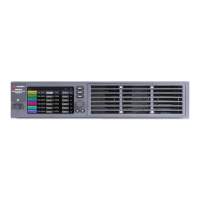OUTPut ON, (@<chanlist>)
OUTPut:PROTection:CLEar (@<chanlist>)
OUTPut:PROTection:COUPle ON
Note that the semicolon follows the implied path of the hierarchical tree structure. In the above
example, the optional :STATe keyword must follow the OUTput keyword to place the command parser
at the second level in the hierarchy. This allows the use of the PROTection keyword after the
semicolon, since PROTection is a second-level keyword. Next, the command parser is placed at the
third level in the hierarchy by the :CLEAR keyword. This allows the use of the COUPle keyword after the
second semicolon, since COUPle is a third-level keyword.
You can also combine commands of different subsystems within the same message string. In this case,
you must use a colon to return the command parser to the root level in order to access another
subsystem. For example, you could clear the output protection and check the status of the Operation
Condition register in one message by using a root specifier as follows:
OUTPut:PROTection:CLEar (@<chanlist>);:STATus:OPERation:CONDition?
(@<chanlist>)
Note the use of the colon after the semicolon in order to return the command parser to the root.
Terminators
A command string sent to the instrument must terminate with a new line (<NL>) character. The IEEE-
488 EOI (End-Or-Identify) message is interpreted as a <NL> character and can be used to terminate a
command string in place of an <NL>. A carriage return followed by a new line (<CR><NL>) is also
accepted. Command string termination will always reset the current SCPI command path to the root
level.
Syntax Conventions
l
Triangle brackets ( < > ) indicate that you must specify a value for the enclosed parameter. For
example, in the VOLTage <value>, (@<chanlist>) command syntax, the <value> and <chanlist>
parameters are enclosed in triangle brackets. The brackets are not sent with the command string.
You must specify a value for the parameters (Example: "VOLTage 50, (@1)".
l
A vertical bar ( | ) separates multiple parameter choices for a given command string. For example,
LATChing|OFF in the OUTPut:INHibit command indicates that you can specify "LATChing" or
"OFF". The bar is not sent with the command string.
l
Square brackets ([ ]) enclose some syntax elements - nodes and parameters for example. This indic-
ates that the element is optional and can be omitted. Thebrackets are not sent with the command
string. In the case of an optional parameter, if you donot specify a value for an optional parameter
the instrument will ignore the parameter. Any keyword enclosed in brackets is optional and can be
omitted. However, if you are combining several commands within the same message string as pre-
viously described, you must include the optional commands to place the command parser at the
correct level in the hierarchy.
Keysight MP4300 Series Operating and Service Guide 99
5 SCPI Programming Reference

